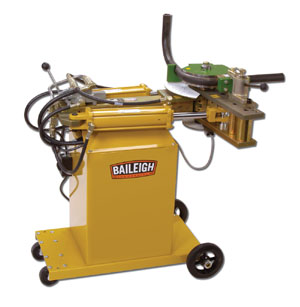There is no clear-cut way to bend a metal tube or pipe. In fact, there may be one method better suited to the type of bending you want to do. Especially if you are bending a piece of metal that is of a higher gauge. We’ve reached out to James Newberg of Baileigh Industrial for a breakdown of the various methods used to bend metal into a desired shape.

Ram Bending
Ram bending is basically direct force applied to the metal piece, which is held in place at its end points. If you can imagine the piston of a car engine punching into a piece of wiring, you have the basic concept for how ram bending works. It’s the cheapest form of bending, and the process is prone to warping. It’s common for the tube or pipe to become deformed during this process, especially if the tubing isn’t very thick.
James says that Ram style bending is used primarily in the shaping of electrical conduit and other wiring that has a lighter gauge. It’s not really suited to the kind of metal work you’d find on a metal gate or inside an automotive shop.
Rotary Draw Bending
Baileigh Industrial’s RDB-150, which stands for “Rotary Draw Bender,” has become one of the most commonly utilized tools for shaping metal. It was the first dual-hydraulic bender and it allows for a 180 degree bend in just one pass through. In rotary draw bending, the metal tubing is drawn through a stationary counter, which is cylindrical in shape. The resulting force gives the metal a clean bend with a smooth finish.
James recommends this kind of bending for ornamental iron work. Baileigh’s tools are helpful in the formation of car chassis and roll cages used in high performance racing. Although the automotive and architectural industries are major use cases for this technology, you can also find this machinery at work in engineering fields that rely on conduit bending too.
Mandrel Bending
Mandrel bending is a highly specialized form of bending that is conducted when trying to avoid any kind of deformation. The major difference between this and rotary bending is the mandrel inserted into the tube. This flexible piece bends with the pipe, helping to maintain its shape from the inside out. Used primarily in the manufacture of car and farm machinery, it is especially effective in situations where stainless steel or aluminum are used.
After talking with James, we learned there is no singularly correct way to bend metal. Often, various techniques are needed depending on what you plan to shape. When you’re fitting a custom metal piece onto your project, be sure that you are using machinery that can give you the type of finish you’re looking for.